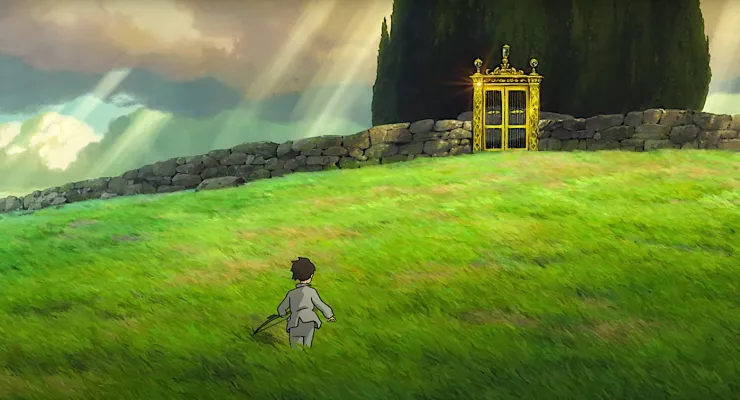Miyazaki Creates an Ambitious, Deeply Emotional Swan-Song

After coming out of retirement again, director Hayao Miyazaki attempts yet another “final movie” in the usual wholesome, child-friendly animation style of Studio Ghibli. Reflecting Miyazaki’s own life, The Boy and the Heron follows Mahito Maki’s (Luca Padovan) life in World War II era Japan. The visual spectacle of bombs dropping and a distant building on fire comes before the death of Mahito’s sick mother, Himi (Karen Fukuhara). After that he moves to the countryside with his father, Shoichi Maki (Christian Bale), where he discovers a strange world between life and death that has a connection to his family. With the help of a talking Grey Heron (Robert Pattinson), Mahito goes to this world to find the missing Natsuko (Gemma Chan), Mahito’s late mother’s sister and the woman meant to be his “new mother.”
Miyazaki brilliantly builds Mahito’s character around his own life, which is why there is so much emotion throughout the film. That and the brilliant voice acting in both the Japanese and English dubs bring this beautiful story to life. The stacked English-dubbed cast is reason alone to watch this movie, with the names previously mentioned, as well as Willem Defoe as the Nobel Pelican, Mark Hamill as the granduncle, and Florence Pugh as Kiriko, and many others. The Japanese voice actors are also amazing in the way they portray the characters. A definite standout in this film is the performance by both Masaki Suda and Pattinson as the Grey Heron, who had a very whimsical and raspy voice.
The art style of The Boy and the Blue Heron is stunning, as most ghibli 2D animated movies are, but this film is unique and has its own beauties that make it one of the best looking animated films. From the color schemes and the imaginative entities drawn to life, to the hand drawn cinematography and careful animation; everything on-screen was an alluring and unparalleled experience for the eyes. Every little particularity, like the footsteps and mannerisms of the characters, is made with so much care and is blooming with life. It’s something that Ghibli has done for decades, but it feels so much more pronounced in this film. Despite its animated nature, it felt too real at some points but more beautiful and nostalgic than uncanny and creepy.
The Boy and the Heron connects to a lot of the previous films by Miyazaki, like its themes of abstract versus real life shared with Spirited Away, as well as its other worldly nature. The soundtrack is incredible, as usual for Ghibli films, and a lot of the tracks evoke deep emotions that really easily resonate with the viewer. Minus the release of some posters, Miyazaki did not market this movie at all, and its outstanding success, hitting number 1 in the box office, was due to English marketing and Miyazaki’s name. The Boy and the Heron is currently playing in theaters and is not on streaming services as of January.
The film is beautiful and ambitious, and it feels like an amazing conclusion to what should seem like Miyazaki’s final work of art (likely not true though). Anyone can experience this deeply emotional, visual buffet and can leave jaw-dropped, scratching their head or with tears in their eyes.
Grade: A+